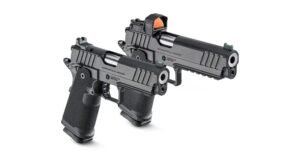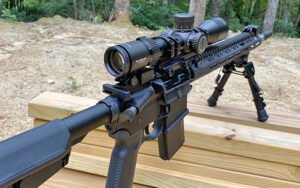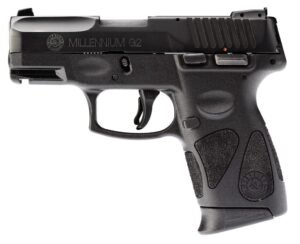5.56 NATO VS .223 WYLDE
People new to the AR-15 can be forgiven for believing that they’re only made to fire the 5.56 NATO cartridge – the same that militaries around the world use (the NATO designation is there for a reason). They’ve also likely heard that for all intents and purposes, the 5.56 NATO and .223 Remington cartridges are pretty much interchangeable in a 5.56 barrel (though a .223 Remington-chambered AR can only safely shoot .223). And they’d be sort of right. Case dimensions are pretty much the same for both. Bullets are similar. Build your AR in 5.56 and you can shoot both. Win-win.
So when we suggest considering a .223 Wylde barrel when planning a build, the reactions we get are sometimes…interesting. There are definitely some misconceptions out there.
.223 Wylde Isn’t a Cartridge
Probably because as those same newbies become slightly more educated, they begin to learn that AR-15s are capable of chambering a plethora of caliber choices. While several of these calibers enjoy mainstream use, and can make great choices when building or buying an AR, it also soon becomes apparent that the AR world is also full of home-cooked, obscure, niche cartridges that never gained enough traction to garner mass-market appeal…so-called “wildcat” cartridges with crazy-sounding names like “.221 fireball” or “.35 Gremlin”. They are generally rare, which translates to either being very expensive, or only an option for those who reload their own ammunition. In other words, not a good choice for beginners or the more casual shooter.
Knowing this, it’s understandable why some yet-to-be-educated folks see a barrel labeled as .223 Wylde and immediately jump to the conclusion that they should stick to something more traditional.
But the thing is, .223 Wylde isn’t some crazy-rare cartridge at all. In fact you won’t find .223 Wylde ammo on any store shelf or on any reloading bench. That’s because .223 Wylde isn’t a caliber, it’s the designation of a chamber dimension. And from a build standpoint, it works just like a 5.56 chambered AR…only better!
Why Did We Need .223 Wylde?
The longer answer? The .223 and 5.56 cartridges are same but different. The 5.56 cartridge is more extreme pressure-wise and also has slightly different dimensions. Without getting too technical, there’s more throat length in a 5.56 chambered barrel – and the angle of the throat is different as to accommodate the increased pressure. While 5.56 can safely shoot .223 Remington, the .223 doesn’t perform as well as it would in a dedicated .223 chamber. Put another way, an AR-15 chambered in 5.56 NATO won’t achieve optimum results with .223 ammo.
So what’s the big deal, you might ask? Why not just shoot 5.56 NATO and be done with it? Well, check some prices and you’ll soon notice a big difference. 5.56 NATO ammunition can easily cost twice as much as .223 Remington.
Along came a guy named Bill Wylde. Bill thought it would be a good idea to design a slightly modified chamber that would be optimized to shoot 5.56 and the .223 Remington equally well. The .223 Wylde has the same chamber angling as the standard 5.56 chamber, so there’s no problem with pressures, and it also has a .2240 freebore diameter. The result? You have a chamber that can still handle the hotter 5.56 military cartridge pressure, and you get the accuracy when shooting the less expensive .223 cartridge.
223 Wylde Trumps 5.56 NATO
So to sum it up, unlike a 5.56 chambered barrel, .223 Wylde allows optimum performance from BOTH .223 Remington and 5.56 NATO cartridges, while still allowing you to use both types of ammunition interchangeably. A shooter can get optimal accuracy while saving money with less expensive ammo.
Optimal performance with less expensive ammo. That sounds like a win. So what’s the downside? Not much. In fact there’s really no good reason to not use a .223 Wylde barrel in our opinion. However, if you’re trying to build as cheaply as possible, you may shave a few dollars by making do with 5.56, as barrels in the .223 Wylde chamber usually come with a slightly higher price tag. But the difference really is minimal, and as barrel manufacturers ramp-up production, that cost difference continues to decreased significantly. The extra $20 for upgrading to .223 Wylde will save you many times that over the long run in the money you’ll save shooting the cheaper ammo.
So don’t be afraid of the .223 Wylde. It does everything a 5.56 NATO barrel does, only better. The Wylde side is where the fun is!
Springfield Armory Prodigy Review
The Springfield Armory Prodigy takes the proven 1911 platform and enhances it with double-stack capacity and a performance-driven feature set.
What is a RECCE Rifle? Meet the Longshot
US Navy Seals developed today’s Recce Rifle concept in the early 90s to bridge the tactical gap between their CQB M4s, and their larger and heavier precision rifles.
Smith & Wesson CSX Review
Smith & Wesson’s CSX joins the market of similar high capacity micro 9s while standing out from the crowd with features and flourishes not found on many competitors.
AR-15 Pistol vs SBR. What’s the difference?
The laws that determine what takes an AR-15 from a pistol or rifle into NFA territory can be both fascinating and headache-inducing. But by keeping few rules of thumb in mind, it’s not as bad as it might seem.
Taurus G2C Review: Amazing Value or Too Good to be True?
Taurus G2C Review The Taurus PT-111 G2 has undergone a few minimal internal improvements and cosmetic changes and released back into the wild as the Taurus G2C. With many retailers offering this subcompact for around the $200 mark, it’s certainly turning a lot of heads and getting a lot of interest. Of course, one of the…






